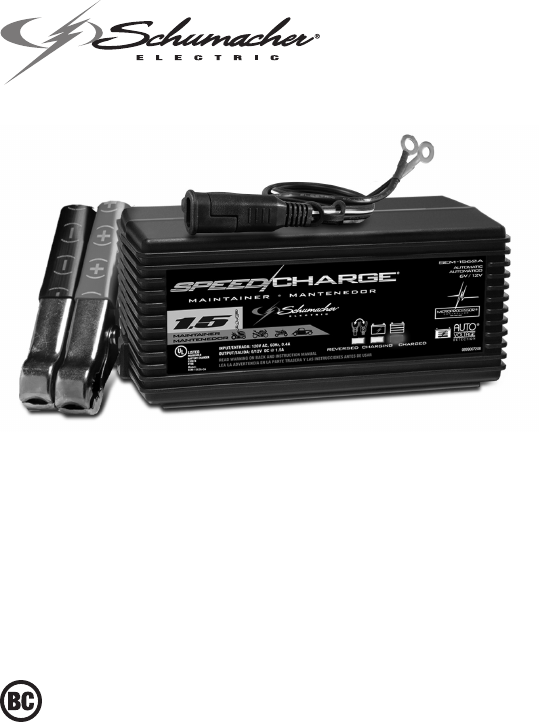
0099001459-01
Model: SEM-1562A-CA
Automatic Battery Charger
OWNERS MANUAL
Voltage: 6, 12
Amperage: 1.5
PLEASE SAVE THIS OWNERS MANUAL AND READ BEFORE EACH USE.
This manual will explain how to use the battery charger safely and effectively.
Please read and follow these instructions and precautions carefully.
NO use el cargador de baterías hasta que haya leído y comprendido
completamente el manual del usuario. Si usted desea una versión
en español de esta edición, visite nuestra página en la red localizada en
www.batterychargers.com así podrá obtener un instructivo del cargador de
baterías en español. Si usted no tiene acceso a la red y necesita asistencia,
llame Servicios al Cliente al (800) 621-5485.

CONTENTS
IMPORTANT SAFETY INSTRUCTIONS ……………………………………………………………………………. 3
PERSONAL SAFETY PRECAUTIONS ………………………………………………………………………………4
PREPARING TO CHARGE ……………………………………………………………………………………………….4
CHARGER LOCATION ……………………………………………………………………………………………………. 5
DC CONNECTION PRECAUTIONS ………………………………………………………………………………….5
FOLLOW THESE STEPS WHEN BATTERY IS INSTALLED IN VEHICLE …………………………….5
FOLLOW THESE STEPS WHEN BATTERY IS OUTSIDE VEHICLE ……………………………………6
GROUNDING AND AC POWER CORD CONNECTIONS …………………………………………………..6
ASSEMBLY INSTRUCTIONS …………………………………………………………………………………………… 7
FEATURES……………………………………………………………………………………………………………………..7
CONTROL PANEL …………………………………………………………………………………………………………..7
OPERATING INSTRUCTIONS …………………………………………………………………………………………. 8
MAINTENANCE AND CARE …………………………………………………………………………………………..11
TROUBLESHOOTING ……………………………………………………………………………………………………11
BEFORE RETURNING FOR REPAIRS ……………………………………………………………………………12
SPECIFICATIONS………………………………………………………………………………………………………….12
REPLACEMENT PARTS ………………………………………………………………………………………………..12
LIMITED WARRANTY ……………………………………………………………………………………………………13
WARRANTY CARD………………………………………………………………………………………………………..15

• 3 •
1. IMPORTANT SAFETY INSTRUCTIONS
SAVE THESE INSTRUCTIONS.
1.1 SAVE THESE INSTRUCTIONS – This manual contains important safety and
operating instructions.
1.2 Keep out of reach of children.
1.3 Do not expose the charger to rain or snow.
1.4 Use of an attachment not recommended or sold by Schumacher
®
Electric
Corporation may result in a risk of re, electric shock or injury to persons.
1.5 To reduce the risk of damage to electric plug and cord, pull by the plug rather
than the cord when disconnecting charger.
1.6 An extension cord should not be used unless absolutely necessary. Use of
improper extension cord could result in a risk of re and electric shock. If an
extension cord must be used, make sure:
• That the pins on plug of extension cord are the same number, size and shape
as those of plug on charger.
• That extension cord is properly wired and in good electrical condition
• That wire size is large enough for AC ampere rating of charger, as specied in
section 8.
1.7 Do not operate charger with damaged cord or plug – replace the cord or plug
immediately.
1.8 Do not operate charger if it has received a sharp blow, been dropped, or
otherwise damaged in any way; take it to a qualied serviceman.
1.9 Do not disassemble charger; take it to a qualied serviceman when service or repair
is required. Incorrect reassembly may result in a risk of electric shock or re.
1.10 To reduce risk of electric shock, unplug charger from outlet before attempting any
maintenance or cleaning. Turning off controls will not reduce this risk.
1.11 WARNING: RISK OF EXPLOSIVE GASES.
a. WORKING IN VICINITY OF A LEAD-ACID BATTERY IS DANGEROUS.
BATTERIES GENERATE EXPLOSIVE GASES DURING NORMAL BATTERY
OPERATION. FOR THIS REASON, IT IS OF UTMOST IMPORTANCE THAT
YOU FOLLOW THE INSTRUCTIONS EACH TIME YOU USE THE CHARGER.
b. To reduce risk of battery explosion, follow these instructions and those
published by battery manufacturer and manufacturer of any equipment you
intend to use in vicinity of battery. Review cautionary markings on these
products and on the engine.

• 4 •
2. PERSONAL SAFETY PRECAUTIONS
2.1 Consider having someone close enough by to come to your aid when you work
near a lead-acid battery.
2.2 Have plenty of fresh water and soap nearby in case battery acid contacts skin,
clothing, or eyes.
2.3 Wear complete eye protection and clothing protection. Avoid touching eyes while
working near battery.
2.4 If battery acid contacts skin or clothing, wash immediately with soap and water.
If acid enters eye, immediately ood eye with running cold water for at least 10
minutes and get medical attention immediately.
2.5 NEVER smoke or allow a spark or ame in vicinity of battery or engine.
2.6 Be extra cautious to reduce risk of dropping a metal tool onto battery. It might spark
or short-circuit battery or other electrical part that may cause explosion.
2.7 Remove personal metal items such as rings, bracelets, necklaces, and watches
when working with a lead-acid battery. A lead-acid battery can produce a short-
circuit current high enough to weld a ring or the like to metal, causing a severe burn.
2.8 Use the charger for charging only 6 and 12V LEAD-ACID, GEL and AGM-type
rechargeable batteries with recommended rated capacities of 12Ah (6V) and
5-33Ah (12V). It is not intended to supply power to a low voltage electrical system
other than in a starter-motor application. Do not use battery charger for charging
dry-cell batteries that are commonly used with home appliances. These batteries
may burst and cause injury to persons and damage to property.
2.9 NEVER charge a frozen battery.
2.10 WARNING: This product contains one or more chemicals known to the State of
California to cause cancer and birth defects or other reproductive harm.
3. PREPARING TO CHARGE
3.1 If necessary to remove battery from vehicle to charge, always remove grounded
terminal from battery rst. Make sure all accessories in the vehicle are off, so as
not to cause an arc.
3.2 Be sure area around battery is well ventilated while battery is being charged.
3.3 Clean battery terminals. Be careful to keep corrosion from coming in contact
with eyes.
3.4 Add distilled water in each cell until battery acid reaches level specied by battery
manufacturer. Do not overll. For a battery without removable cell caps, such as valve
regulated lead acid batteries, carefully follow manufacturer’s recharging instructions.
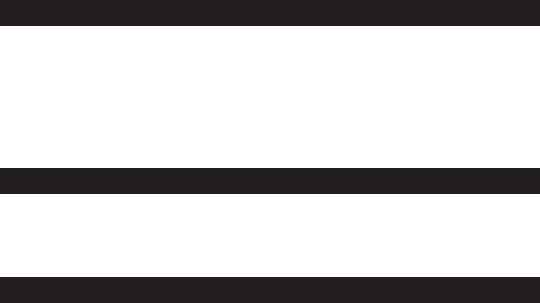
• 5 •
3.5 Study all battery manufacturer’s specic precautions while charging and
recommended rates of charge.
3.6 Determine voltage of battery by referring to car owner’s manual and make
sure that output voltage selector switch is set at correct voltage. If charger has
adjustable charge rate, charge battery initially at lowest rate.
4. CHARGER LOCATION
4.1 Locate charger as far away from battery as DC cables permit.
4.2 Never place charger directly above battery being charged; gases from battery will
corrode and damage charger.
4.3 Never allow battery acid to drip on charger when reading electrolyte specic
gravity or lling battery.
4.4 Do not operate charger in a closed-in area or restrict ventilation in any way.
4.5 Do not set a battery on top of charger.
5. DC CONNECTION PRECAUTIONS
5.1 Connect and disconnect DC output clips only after setting any charger switches
to “off” position and removing AC cord from electric outlet. Never allow clips to
touch each other.
5.2 Attach clips to battery and chassis, as indicated in sections 6 and 7.
6. FOLLOW THESE STEPS WHEN BATTERY IS INSTALLED IN VEHICLE
WARNING: A SPARK NEAR THE BATTERY MAY CAUSE A BATTERY
EXPLOSION. TO REDUCE THE RISK OF A SPARK NEAR THE BATTERY:
6.1 Position AC and DC cords to reduce risk of damage by hood, door, or moving
engine part.
6.2 Stay clear of fan blades, belts, pulleys, and other parts that can cause injury to persons.
6.3 Check polarity of battery posts. POSITIVE (POS, P, +) battery post usually has
larger diameter than NEGATIVE (NEG, N,–) post.
6.4 Determine which post of battery is grounded (connected) to the chassis. If
negative post is grounded to chassis (as in most vehicles), see (6.5). If positive
post is grounded to the chassis, see (6.6).
6.5 For negative-grounded vehicle, connect POSITIVE (RED) clip from battery
charger to POSITIVE (POS, P, +) ungrounded post of battery. Connect
NEGATIVE (BLACK) clip to vehicle chassis or engine block away from battery. Do
not connect clip to carburetor, fuel lines, or sheet-metal body parts. Connect to a
heavy gauge metal part of the frame or engine block.

• 6 •
6.6 For positive-grounded vehicle, connect NEGATIVE (BLACK) clip from battery
charger to NEGATIVE (NEG, N, –) ungrounded post of battery. Connect
POSITIVE (RED) clip to vehicle chassis or engine block away from battery. Do
not connect clip to carburetor, fuel lines, or sheet-metal body parts. Connect to a
heavy gauge metal part of the frame or engine block.
6.7 When disconnecting charger, turn switches to off, disconnect AC cord, remove clip
from vehicle chassis, and then remove clip from battery terminal.
6.8 See Operating Instructions for length of charge information.
7. FOLLOW THESE STEPS WHEN BATTERY IS OUTSIDE VEHICLE
WARNING: A SPARK NEAR THE BATTERY MAY CAUSE A BATTERY
EXPLOSION. TO REDUCE THE RISK OF A SPARK NEAR THE BATTERY:
7.1 Check polarity of battery posts. POSITIVE (POS, P, +) battery post usually has a
larger diameter than NEGATIVE (NEG, N, –) post.
7.2 Attach at least a 24-inch-long 6-gauge (AWG) insulated battery cable to
NEGATIVE (NEG, N, –) battery post.
7.3 Connect POSITIVE (RED) charger clip to POSITIVE (POS, P, +) post of battery.
7.4 Position yourself and free end of cable as far away from battery as possible –
then connect NEGATIVE (BLACK) charger clip to free end of cable.
7.5 Do not face battery when making nal connection.
7.6 When disconnecting charger, always do so in reverse sequence of connecting
procedure and break rst connection while as far away from battery as practical.
7.7 A marine (boat) battery must be removed and charged on shore. To charge it on
board requires equipment specially designed for marine use.
8. GROUNDING AND AC POWER CORD CONNECTIONS
8.1 This battery charger is for use on a nominal 120 volt circuit. The plug must be
plugged into an outlet that is properly installed and grounded in accordance with
all local codes and ordinances. The plug pins must t the receptacle (outlet). Do
not use with an ungrounded system.
8.2 DANGER: Never alter the AC cord or plug provided – if it does not t the outlet,
have a proper grounded outlet installed by a qualied electrician. An improper
connection can result in a risk of an electric shock or electrocution.
NOTE: Pursuant to Canadian Regulations, use of an adapter plug is not allowed
in Canada. Use of an adapter plug in the United States is not recommended and
should not be used.
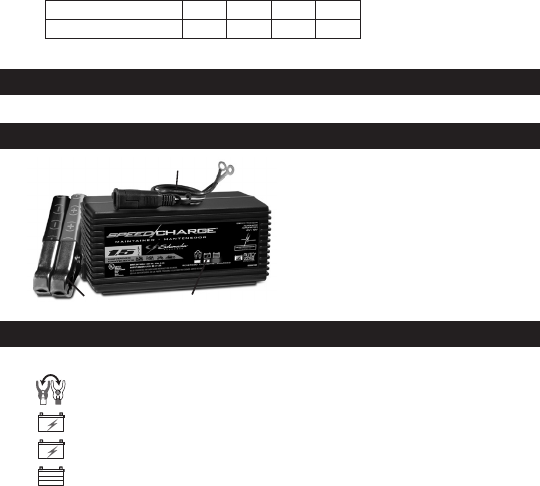
• 7 •
8.3 USING AN EXTENSION CORD
The use of an extension cord is not recommended. If you must use an extension
cord, follow these guidelines:
• Pins on plug of extension cord must be the same number, size, and shape as
those of plug on charger.
• Ensure that the extension cord is properly wired and in good electrical condition.
• Wire size must be large enough for the AC ampere rating of charger, as specied:
Length of cord (feet) 25 50 100 150
AWG* size of cord 18 18 18 16
*AWG-American Wire Gauge
9. ASSEMBLY INSTRUCTIONS
9.1 Remove all cord wraps and uncoil the cables prior to using the battery charger.
10. FEATURES
1. Ring connectors (quick-connect)
2. Battery clamps (quick-connect)
3. Battery status LEDs
2
3
1
11. CONTROL PANEL
LED DISPLAY
CLAMPSREVERSED(red)LEDashing: The connections are reversed.
CHARGING (yellow/orange) LED lit: The charger is charging the battery.
CHARGING(yellow/orange)LEDashing: The charger is in abort mode.
CHARGED (green) LED pulsing: The battery is fully charged and the
charger is in maintain mode.
NOTE: See Operating Instructions for a complete description of the charger modes.

• 8 •
12. OPERATING INSTRUCTIONS
IMPORTANT: Do not start the vehicle with the charger connected to the AC
outlet, or it may damage the charger and your vehicle.
NOTE: This charger is equipped with an auto-start feature. Current will not be
supplied to the battery clamps until a battery is properly connected. The clamps
will not spark if touched together.
CHARGING A BATTERY IN THE VEHICLE
1. Turn off all the vehicle’s accessories.
2. Keep the hood open.
3. Clean the battery terminals.
4. Place the charger on a dry, non-ammable surface.
5. Lay the AC/DC cables away from any fan blades, belts, pulleys and other
moving parts.
6. Connect the battery, following the precautions listed in sections 6 and 7.
7. Connect the charger to an electrical outlet.
8. When charging is complete, disconnect the charger from the AC power, remove
the clamps from the vehicle’s chassis, and then remove the clamp from the
battery terminal.
CHARGING A BATTERY OUTSIDE OF THE VEHICLE
1. Place battery in a well-ventilated area.
2. Clean the battery terminals.
3. Connect the battery, following the precautions listed in sections 6 and 7.
4. Connect the charger to the electrical outlet.
5. When charging is complete, disconnect the charger from the AC power,
disconnect the negative clamp, and nally the positive clamp.
6. A marine (boat) battery must be removed and charged on shore.

• 9 •
USING THE QUICK-CONNECT CABLE CONNECTORS
Connect either of the two (2) output cable leads to the charger. Make sure to
place the charger on a dry, non-ammable surface.
WARNING: Never connect the clamp and ring terminal connectors together
for use in other applications, such as external battery or other power source
charging, or to extend the output cable length, as reverse polarity and/or
overcharge conditions will occur.
USING THE 50 AMP BATTERY CLAMPS
1. Connect the end of the charger output cable to the end of the battery cable,
quick-connect and clamps.
2. Follow the steps in sections 6 and 7 to connect the output clamps to the battery.
3. Connect the charger to an electrical power outlet.
USING THE RING CONNECTORS
1. To permanently attach to a battery, loosen and remove each nut from the bolt
at the battery terminal.
2. Connect the red POSITIVE connector ring to the POSITIVE battery terminal.
3. Connect the black NEGATIVE connector ring to the NEGATIVE battery terminal.
4. Replace and tighten the nuts to secure.
5. Connect the cable to the end of the charger output cord. Take care to keep
the wires and plug away from metal and moving parts.
6. Connect the charger to an electrical power outlet.
BATTERY CHARGING TIMES
CCA = Cold Cranking Amps RC = Reserve Capacity Ah = Amp Hour
BATTERY SIZE/RATING CHARGE TIME (1.5A)
SMALL BATTERIES
Motorcycle, garden tractor, etc.
6-12 Ah 2¾-5 h
12-32 Ah 5-13¼ h
CARS AND TRUCKS
200-315 CCA 40-60 RC 15-19¼ h
315-550 CCA 60-85 RC 19¼-24½ h
550-1000 CCA 85-190 RC 24½-46¼ h
MARINE/DEEP-CYCLE
80 RC 23½ h
140 RC 36 h
160 RC 40 h
180 RC 44 h
Times are based on a 50% discharged battery and may change, depending on age and
condition of battery.
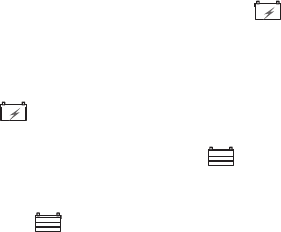
• 10 •
AUTOMATIC CHARGING MODE
When an automatic charge is performed, the charger switches to the maintain
mode (see below) automatically after the battery is charged.
ABORTED CHARGE
If charging cannot be completed normally, charging will abort. When charging
aborts, the charger’s output is shut off and the CHARGING
(yellow/orange)
LED will ash. To reset after an aborted charge, unplug the charger from the AC
outlet, wait a few moments and plug it back in.
DESULFATION MODE
Desulfation could take 8 to 10 hours. If desulfation fails, charging will abort and
the CHARGING
(yellow/orange) LED will ash.
COMPLETION OF CHARGE
Charge completion is indicated by the CHARGED
(green) LED. When
pulsing, the charger has switched to the maintain mode of operation.
MAINTAIN MODE (FLOAT MODE MONITORING)
When the CHARGED
(green) LED is pulsing, the charger has started
maintain mode. In this mode, the charger keeps the battery fully charged by
delivering a small current when necessary. If the charger has to provide its
maximum maintain current for a continuous 12 hour period, it will go into abort
mode (see Aborted Charge section). This is usually caused by a drain on the
battery or the battery could be bad. Make sure there are no loads on the battery.
If there are, remove them. If there are none, have the battery checked or replaced.
MAINTAINING A BATTERY
The SEM-1562A-CA maintains both 6 and 12 volt batteries, keeping them at full charge.
NOTE: The maintain mode technology allows you to safely charge and maintain a
healthy battery for extended periods of time. However, problems with the battery,
electrical problems in the vehicle, improper connections or other unanticipated
conditions could cause excessive current draws. As such, occasionally monitoring
your battery and the charging process is recommended.

• 11 •
13. MAINTENANCE AND CARE
A minimal amount of care can keep your battery charger working properly for years.
• Clean the clamps each time you are nished charging. Wipe off any battery uid
that may have come in contact with the clamps, to prevent corrosion.
• Occasionally cleaning the case of the charger with a soft cloth will keep the nish
shiny and help prevent corrosion.
• Coil the input and output cords neatly when storing the charger. This will help
prevent accidental damage to the cords and charger.
• Store the charger unplugged from the AC power outlet, in an upright position.
• Store inside, in a cool, dry place. Do not store the clamps clipped together, on or
around metal, or clipped to the cables.
14. TROUBLESHOOTING
PROBLEM POSSIBLE CAUSE REASON/SOLUTION
Battery clamps do not
spark when touched
together.
The charger is equipped
with an auto-start feature.
It will not supply current to
the battery clamps until a
battery is properly connected.
The clamps will not spark if
touched together.
No problem; this is a
normal condition.
All three LEDs come
on for 2 seconds, then
turn off.
The charger is plugged into
an AC outlet.
No problem; this is
normal.
The charger will not
turn on when properly
connected.
AC outlet is dead.
Poor electrical connection.
Battery is defective.
Check for open fuse or
circuit breaker supplying
AC outlet.
Check power cord and
extension cord for loose
tting plug.
Have battery checked.
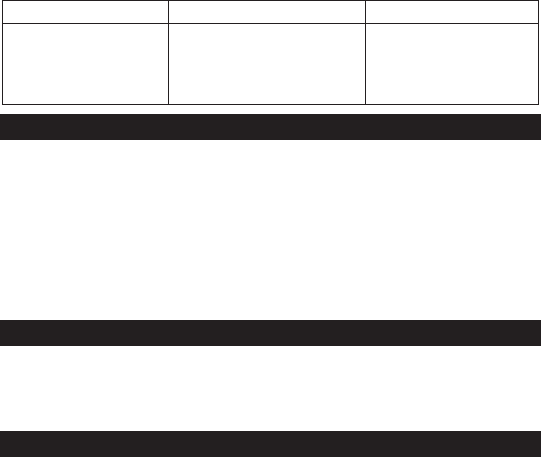
• 12 •
PROBLEM POSSIBLE CAUSE REASON/SOLUTION
I cannot select a 6V or
12V setting.
The charger is equipped with
Auto Voltage Detection, which
automatically detects the
voltage and charges the battery.
No problem; this is
normal.
15. BEFORE RETURNING FOR REPAIRS
For information about troubleshooting,
contact customer service for assistance:
services@schumacherelectric.com
www.batterychargers.com
or call 1-800-621-5485, Monday-Friday 7:00am to 5:00pm CST
For REPAIR OR RETURN, contact Customer Service at 1-800-621-5485.
DO NOT SHIP UNIT until you receive a RETURN MERCHANDISE AUTHORIZATION
(RMA) number from Customer Service at Schumacher Electric Corporation.
16. SPECIFICATIONS
Input Voltage ………………………………………………………….120V AC
@
60Hz, .40A
Output Voltage …………………………………6V or 12V, with Auto Voltage Detection
Output Current Rating …………………………………………………..1.5A
@
6V and 12V
17. REPLACEMENT PARTS
Ring connectors (quick-connect) ……………………………………………2299001950Z
Battery clamps (quick-connect) ……………………………………………..3899001404Z

• 13 •
18. LIMITED WARRANTY
WARRANTY NOT VALID IN MEXICO.
SCHUMACHER ELECTRIC CORPORATION, 801 BUSINESS CENTER DRIVE,
MOUNT PROSPECT, IL 60056-2179, MAKES THIS LIMITED WARRANTY TO
THE ORIGINAL RETAIL PURCHASER OF THIS PRODUCT. THIS LIMITED
WARRANTY IS NOT TRANSFERABLE OR ASSIGNABLE.
Schumacher Electric Corporation (the “Manufacturer”) warrants this charger for
two (2) years from the date of purchase at retail against defective material or
workmanship that may occur under normal use and care. If your unit is not free
from defective material or workmanship, Manufacturer’s obligation under this
warranty is solely to repair or replace your product with a new or reconditioned unit
at the option of the Manufacturer. It is the obligation of the purchaser to forward the
unit, along with proof of purchase and mailing charges prepaid to the Manufacturer
or its authorized representatives in order for repair or replacement to occur.
Manufacturer does not provide any warranty for any accessories used with this
product that are not manufactured by Schumacher Electric Corporation and
approved for use with this product. This Limited Warranty is void if the product is
misused, subjected to careless handling, repaired, or modied by anyone other
than Manufacturer or if this unit is resold through an unauthorized retailer.
Manufacturer makes no other warranties, including, but not limited to, express,
implied or statutory warranties, including without limitation, any implied warranty
of merchantability or implied warranty of tness for a particular purpose. Further,
Manufacturer shall not be liable for any incidental, special or consequential damage
claims incurred by purchasers, users or others associated with this product, including,
but not limited to, lost prots, revenues, anticipated sales, business opportunities,
goodwill, business interruption and any other injury or damage. Any and all such
warranties, other than the limited warranty included herein, are hereby expressly
disclaimed and excluded. Some states do not allow the exclusion or limitation of
incidental or consequential damages or length of implied warranty, so the above
limitations or exclusions may not apply to you. This warranty gives you specic legal
rights and it is possible you may have other rights which vary from this warranty.
THIS LIMITED WARRANTY IS THE ONLY EXPRESS LIMITED WARRANTY AND
THE MANUFACTURER NEITHER ASSUMES OR AUTHORIZES ANYONE TO
ASSUME OR MAKE ANY OTHER OBLIGATION TOWARDS THE PRODUCT
OTHER THAN THIS WARRANTY.
Schumacher
®
and the Schumacher logo are registered
trademarks of Schumacher Electric Corporation.
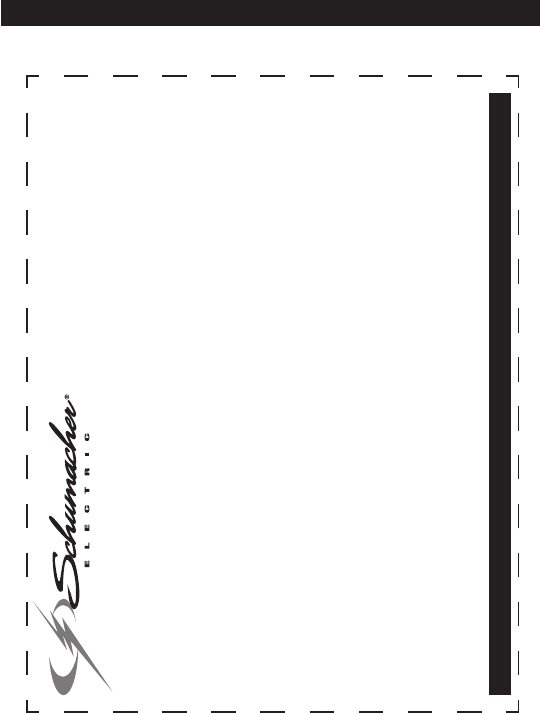
• 15 •
2 YEAR LIMITED
WARRANTY PROGRAM
REGISTRATION
MODEL: _____________________ DESCRIPTION: ________________________
This is the only express limited warranty, and the manufacturer neither assumes
nor authorizes anyone to assume or make any other obligation. There is no other
warranty, other than what is described in the product owner’s manual.
The warranty card should be submitted within 30 days of purchase. The customer
must keep the ORIGINAL receipt because it will be required for any warranty claims.
This warranty is not transferable. Send warranty card only.
DO NOT SEND UNIT TO THIS ADDRESS FOR REPAIR.
Mail this card to: Schumacher Electric Corporation
801 Business Center Drive
Mount Prospect, IL 60056-2179
Name ______________________________________________________________
Street Address _______________________________________________________
City ________________________________State _________ Zip Code _________
Phone _____________________Email ___________________________________
Store Name Where Purchased ___________________ Date of Purchase _________
Store Location ____________________ UPC Number ________________________
Serial Number ______________________________________ (SEE PRODUCT)
For faster warranty activation, go to www.batterychargers.com to register your product online.
SAVE ON POSTAGE! ACTIVATE YOUR WARRANTY ONLINE – THE QUICK AND EASY WAY!
Go to www.batterychargers.com to register your product online.
(No internet access? Send in the completed warranty card.)
WARRANTY CARD